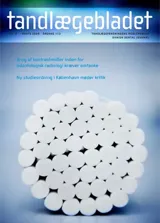Odontologisk spesialisering i radiologi
Det har siden 1970-tallet vært en revolusjonerende utvikling innen diagnostisk radiologi. Avanserte data- assisterte snittavbildningsmetoder slik som compu- tertomografi (CT) og magnetisk resonans (MR) tomo- grafi anvendes i stadig økende grad for diagnostiske utredninger av den maxillofaciale regionen. På slutten av 1990-tallet kom en ny type CT på markedet, cone beam CT, som er velegnet for undersøkelse av kjeve- og ansiktsskjelettet. Den teknologiske utviklingen har ført til økende behov for spesialisering. I tillegg til det røntgendiagnostiske ansvaret skal spesialisten være ansvarlig for at metodene anven- des på en kostnadseffektiv måte hva angår økonomi og stråledoser. Europa, og særlig Norden ligger her i første rekke, idet både Sverige, Finland og Norge har godkjent spesialistutdanninger. Dette er 3-årige fulltidsutdanninger som stort sett er i samsvar med retningslinjer utviklet av European Academy of Den- tal and Maxillofacial Radiology. I artikkelen gis en in- troduksjon til fagdisiplinen i de enkelte nordiske land, likheter og forskjeller slik som lønn under utdanning eller ikke, og ikke minst tilgjengelighet av spesialisttjenesten; det er her stor forskjell mellom Sverige og Finland i forhold til Norge. I Danmark, som ikke har spesialitet, gir den teknologiske utviklingen grunn til bekymring grunnet den manglende kompetansen i avansert diagnostisk radiologi av den maxillofaciale regionen.
Odontological specialization in radiology: The article is a review of the specialist training in maxillofacial radiology. Three Nordic countries have such programmes: Sweden and Finland have had recognized specialties for more than 25 years and Norway since 2006. The availability of the specialist service is therefore much better in Sweden and Finland than in Norway. There are also great differences concerning salary during the training period. Whereas the specialist candidates do get a salary from the state in Finland, candidates in Norway receive no such from either the state or county (2008). The postgraduate programmes in these countries are broadly in accordance with the guidelines developed by the Specialist Committee in the European Academy of Dental and Maxillofacial Radiology (EADMFR). The programmes are three years full-time and a large portion of the time is used to obtain clinical competence in the application of advanced radiological modalities for examination and diagnostics of the maxillofacial region. In Denmark, the only Nordic country without such specialty, there is an obvious need for a specialist programme be cause of technological development and the inherent diagnostic responsibility. CBCT scanners produce tomographic images that are more or less identical with those produced by conventional CT scanners, and the different machines operate with a radiation field varying from a few cm to including greater parts of the head. To ensure a responsible use of advanced modalities there is a need for a postgraduate programme after the undergraduate curriculum. A number of countries in Europe, such as Poland, Hungary, Turkey and Germany have realized this and many are working to obtain a national speciality. The specialist document developed by the EADMFR, available on the Internet, will be of great importance for nations that are developing specialist programmes. The EADMFR is also working intensively to develop scientifically based guidelines to ensure the responsible use of CBCT. This work is supported by EU/EUROTOM (European Atomic Energy Community).


